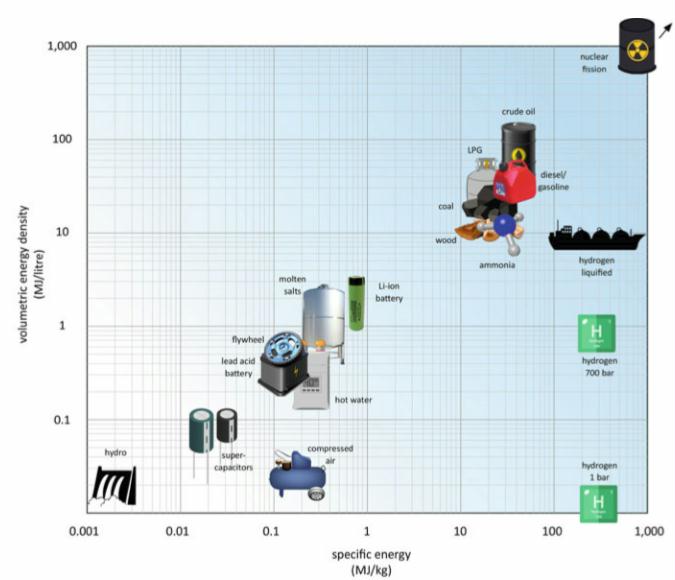
Volumetric versus specific energy density for selected energy carriers. Source: Palmer, G. 2020. Energy storage & civilization: a systems approach. Springer.
Preface. Vaclav Smil writes “The fact that wind, solar, and biomass have incredibly low energy density per square meter means that a fully renewable system to replace the 320 GW of fossil fueled electricity generation and 1.8 TW of coal, oil, and gas with biofuels would take up up to 50% of the America’s territory, 1.81 million square miles (250-470 Mha), since the average power density of biomass is just 0.45 W/m2 to produce liquid biofuels.”
Alice Friedemann www.energyskeptic.com Women in ecology author of 2021 Life After Fossil Fuels: A Reality Check on Alternative Energy best price here; 2015 When Trucks Stop Running: Energy and the Future of Transportation”, Barriers to Making Algal Biofuels, & “Crunch! Whole Grain Artisan Chips and Crackers”. Podcasts: Crazy Town, Collapse Chronicles, Derrick Jensen, Practical Prepping, KunstlerCast 253, KunstlerCast278, Peak Prosperity
***
Smil V (2015) Power Density: A Key to Understanding Energy Sources and Uses. MIT Press.
If we were to cultivate phytomass at 1 W/m2 to replace today’s 12.5 TW of fossil fuels would require 4,826,275 million square miles (12.5 million square kilometers), roughly the size of the U.S. and India. If all of America’s gasoline demands were derived from ethanol, that would take an area 20% larger than the nation’s total arable land. It would be worse elsewhere — the U.S. produces twice as much corn per acre than the rest of the world.
If the U.S. tried to generate 10% of electricity (405 Twh in 2012) it would require wood chips from forests growing in an area the size of Minnesota (84,950 square miles) since the power density is only 0.6 W/m2.
Currently the area used by fossil fuel production and extraction, hydro power, and nuclear generation takes up only 0.5% of the land (21,235 square miles, 5.5 Mha). The low energy density of biofuels restricts facilities to small areas or the fossil fuel used to transport it to the biorefinery is more than the energy of what’s made (i.e. corn for ethanol needs to be less than 50 miles away)
Power density in watts per square meter
- Rich middle eastern oil fields: > 10,000 W/m2
- American oil fields: 1,000-2,000 W/m2
- Natural gas 1,000 to 10,000 W/m2
- Coal: 250-500 W/m2 (used to be much higher but the best coal mines were mined first, remaining mines have lower energy density coal) though it can be 1,000 to 10,000 W/m2 in bituminous thick coal seams
- Fast growing trees in plantations: 1 W/m2 (arid) 1 W/m2 (temperate) 1.2 W/m2 tropical
- Bioengineered trees that don’t exist yet: 2 W/m2 but not really, they’d be constrained by nutrients, fertilizer inputs, soil erosion, and 10 years or more between harvests
- Harvesting mature virgin forests or coppiced beech or oak: 0.22-0.25 W/m2
- Crop residues: 0.05 W/m2
- ethanol: 0.25 W/m2
- Biodiesel: 0.12 to 0.18 W/m2
- Solar 2.7 W/m2 (Germany’s Waldpolenz)
- Wind turbines: 2 to 10 W/m2.
- hydropower: 3 W/m2 due to large reservoir size, Three gorges will be as high as 30 W/m2 though
Consumption. Wind, solar, biomass take too much land to support today’s industries and cities, from 500 W/m2 to 1,000 W/m2 at industrial facilities (especially steel mills and refineries), downtown’s in northern cities in the winter, and high-rise buildings.
All About Power Density. A Comparison of Various Energy Sources in Horsepower (and Watts:
- Nuclear: 56 Watts per square meter (W/m2). 300 Horsepower (HP)/acre (56 W/m2)
- Average U.S. natural gas well @ 115,000 cubic feet per day: 53 W/m2. 287.5 hp/acre
- Solar PV: 7 W/M2. 36 hp/acre
- Wind turbines: 2 W/m2. 6.4 hp/acre
- Biomass-fueled power plant: 4 W/M2. 2.1 hp/acre
- Corn ethanol: 05 W/M2. 0.26 hp/acre

One Response to Power density of biomass, wind, & solar take too much land to replace fossil fuels